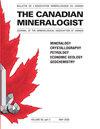温度为900至300°C的Cu–Fe–Se相系统的中心部分
IF 1.5
4区 地球科学
Q3 MINERALOGY
引用次数: 1
摘要
在900、750、600、500、450、350和300°C的真空二氧化硅玻璃管中,通过干法合成的方法研究了Cu–Fe–Se凝聚相系统的中心部分。通过反射光显微镜和电子探针分析对合成产物进行了研究。硫化物熔体的场在900°C时是广泛的,在750°C时向Cu–Se侧逐渐后退;残余的硒化物熔体在600°C时仍然存在。iss的硒类似物仅在600°C及以下发现;斑铜矿在500°C及以下变得个体化,而斑铜矿固溶体的硒类似物在所有研究温度下都存在,尽管温度降低的程度有所降低。三种硒化铁(β,γ,δ)对铜表现出相当大的溶解度,对于类麦金铁矿的βFeSe来说,在300°C时铜的溶解度达到14at.%。FeSe2与各向同性固溶体(Cu,Fe)Se2表现出不混溶间隙,其组成随着温度的降低而逐渐向富Cu方向变化。强调了与硫基系统的异同。本文章由计算机程序翻译,如有差异,请以英文原文为准。
The central portions of the Cu–Fe–Se phase system at temperatures from 900 to 300 °C
The central portions of the condensed phase system Cu–Fe–Se were investigated by means of dry syntheses in evacuated silica glass tubes at 900, 750, 600, 500, 450, 350, and 300 °C. Synthesis products were studied by reflected-light microscopy and electron microprobe analyses. The field of sulfide melt is extensive at 900 °C and retreats progressively towards the Cu–Se side at 750 °C; residual selenide melt persists at 600 °C. The selenium analogue of iss was found only at and below 600 °C; eskebornite becomes individualized at and below 500 °C, whereas the selenium analogue of bornite solid solution is present at all investigated temperatures, although with reduced extent on temperature decrease. The three iron selenides (β, γ, δ) display considerable solubility of copper, which for the mackinawite-like β FeSe reaches 14 at.% Cu at 300 °C. FeSe2 displays an immiscibility gap with isotropic solid solution (Cu,Fe)Se2, the composition of which gradually changes towards Cu-rich with decreasing temperature. Similarities and differences with the sulfur-based system are highlighted.
求助全文
通过发布文献求助,成功后即可免费获取论文全文。
去求助
来源期刊

Canadian Mineralogist
地学-矿物学
CiteScore
2.20
自引率
22.20%
发文量
45
审稿时长
4-8 weeks
期刊介绍:
Since 1962, The Canadian Mineralogist has published papers dealing with all aspects of mineralogy, crystallography, petrology, economic geology, geochemistry, and applied mineralogy.
 求助内容:
求助内容: 应助结果提醒方式:
应助结果提醒方式:


